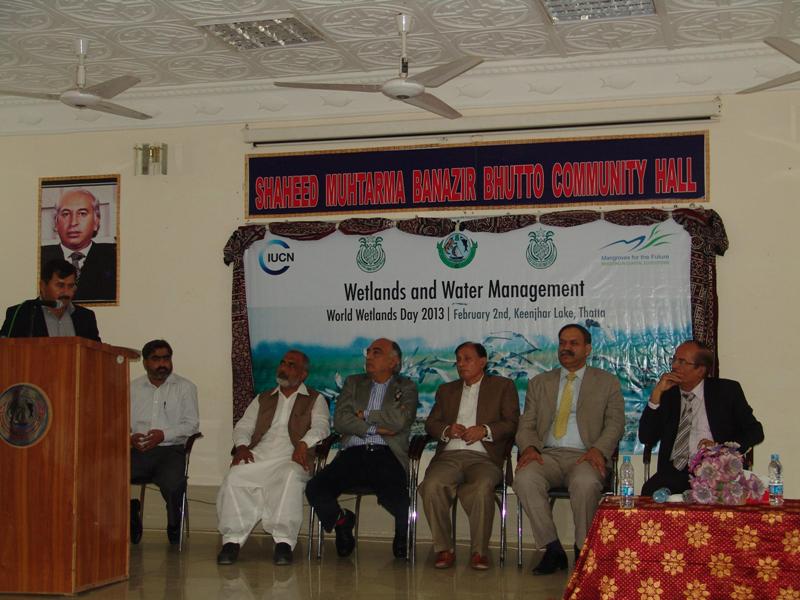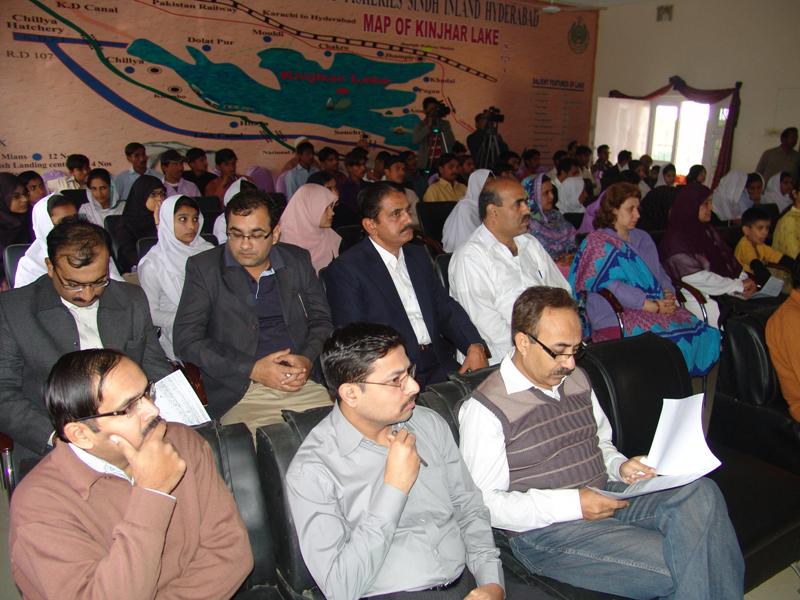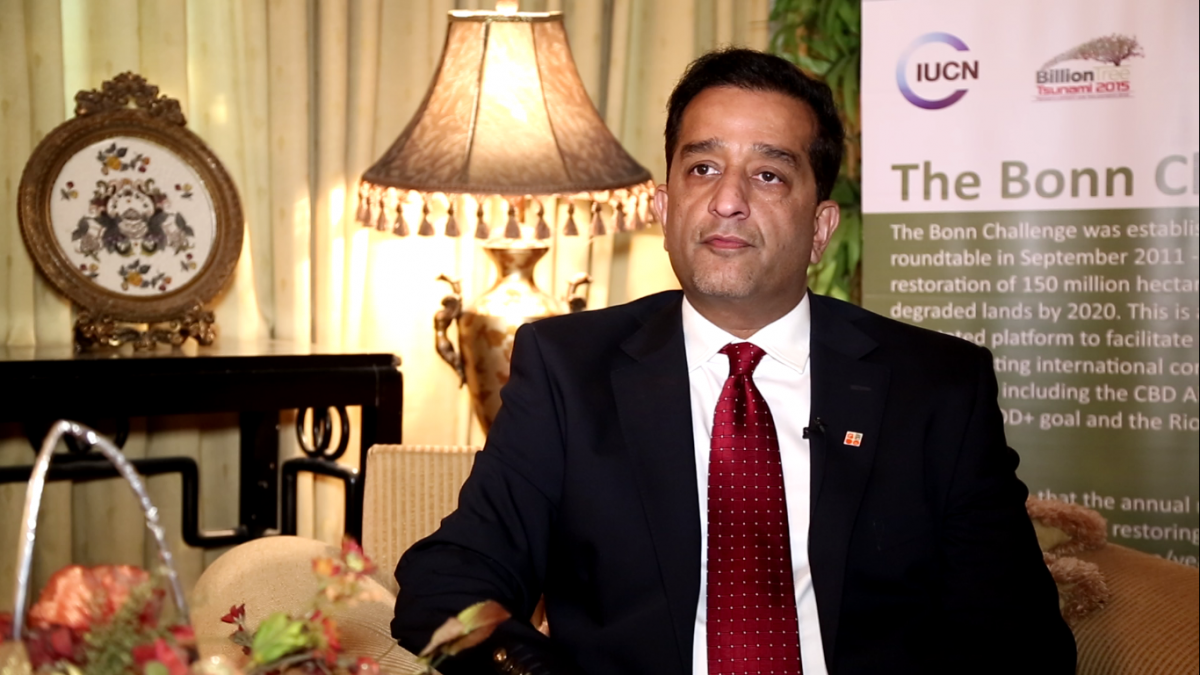World Wetlands Day celebrated at Keenjhar Lake, the largest fresh water source for the cities of Karachi and Thatta
IUCN Pakistan in collaboration with the Mangroves for the Future Programme, Sindh Coastal Community Project of the Sindh Coastal Development Authority, and Sindh Fisheries Department, celebrated the World Wetland Day at the Keenjhar Lake, Thatta, to highlight the importance of the Keenjhar freshwater ecosystem on February 02, 2013.
Over 150 people attended the event, including water and natural resources management experts, students, media and the government officials.
The United Nations General Assembly has declared 2013 as the United Nations International Year of Water Cooperation and Ramsar’s theme for the World Wetland’s Day for this year is “Wetlands and Water Management”.
The idea behind selecting Keenjhar Lake as a venue was to highlight the importance of the wetlands in providing fresh water. Not only it is a Ramsar protected site but 95% of Karachi’s water needs are fulfilled through Keenjhar, making it the largest source of water supply for Karachi. According to Karachi Water & Sewerage Board, each day, about 580 MGD of water from Keenjhar is supplied to the city. Study reports on Keenjhar state that the lake hosts, around 55 freshwater fish species.
In the opening remarks, Country Representative IUCN Pakistan, Mr. Mahmood Akhtar Cheema spoke about constant decrease in water availability in Pakistan. He said that in 1947, per capita water availability was 5000 cubic meter which has reduced to 1000 cubic meter. He was of the view that vegetative cover is essential for water conservation and ground water storage, which is alarmingly low in Pakistan, and stands at 5% of the total landmass whereas in India it is 23%. The neighbouring countries are heavily investing for increasing their vegetative cover as it helps in conserving the water. Water is interconnected with agriculture and fisheries and thousands of livelihoods are dependent on it. He stressed on the need for Pakistan to work with the neighboring countries to have a dialogue on water as it is a shared resource.
In his keynote address, Mr. Shams-ul-Haq Memon, Consultant, Sindh Coastal Development Authority spoke about how Ramsar sites are declared on the basis of the richness of biodiversity. He spoke about how the term “Wetlands” covers many different water bodies. It includes lakes, rivers, man-made lakes, and also water standing in the farms. Wetlands not only have a bearing on the fishing industry, but also on tourism industry and others. For sustained life on this planet, we need to keep the wetlands clean.
Mr. Ghulam Qadir Shah, Coordinator Mangroves for the Future Programme Pakistan, highlighted the natural wealth that Keenjhar Lake offered many years ago. At one point, the Bengal tiger and gharial resided in the wetlands of Pakistan but are now extinct. Marine turtles and Indus dolphins are also endangered. Also, there were over 120,000 trees at the Haleji Lake but then they were cut down since the water supply to the Indus gradually decreased with the construction of dams, resulting in the unfortunate loss. He said that Kotri and Nooriabad waste also comes to Keenjhar affecting its water quality. He spoke about how 15% of Sindh’s GDP is wasted due to the environmental degradation, which is the highest in the world. He said that the Mangroves for the Future Programme, with its secretariat-based at IUCN Pakistan, is trying to do its bit by giving small and medium-sized grants to the organisations working in the coastal areas and providing training to the communities.
Mr. Muhammad Umar Memon, Project Director, Sindh Coastal Development Authority also spoke on the occasion about improving coastal zone management and increasing fresh water for healthier mangroves.
Mr. Ghulam Mujtaba Waddal, Director, Sindh Fisheries Department shared a presentation on the Keenjhar Lake. He spoke about the spillway that the Government of Sindh has constructed, which has increased the life of the Keenjhar lake. He mentioned that there are 8 centers around the lake where the fishermen sell their fish. About 45000 people live around the lake who are dependent on it for their livelihoods.
Mr. Ghulam Muhammad Mahar, Director General Sindh Fisheries Department thanked the participants for sharing their research and raising awareness about the Keenjhar Lake, and their insights on safeguarding the wetlands for our future generations and the communities dependent on it.
In the closing remarks Mr. Mohammd Hanif Pathan, Director General, Sindh Coastal Development Authority thanked IUCN and other partners for organizing such an informative programme at an important and most relevant location to the event. He encouraged the participants to do more for the conservation of wetlands.
At the end of the progrmame a ceremonial plantation of the saplings was carried out in the vicinity of the Fisheries Department’s office and the commemorative shields were distributed amongst the presenters.
For more information, please contact:
Ms. Madiha Aijaz, Coordinator, Education Communications and Outreach
Cell: 0345-2004154, email: madiha.aijaz@iucn.org





